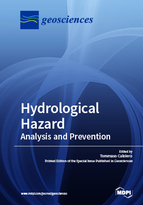Hydrological Hazard: Analysis and Prevention
A special issue of Geosciences (ISSN 2076-3263). This special issue belongs to the section "Natural Hazards".
Deadline for manuscript submissions: closed (31 March 2018) | Viewed by 68120
Special Issue Editor
Interests: hydrology; climatology; climate change; natural hazards; land use chance; forest ecology
Special Issues, Collections and Topics in MDPI journals
Special Issue Information
Dear Colleagues,
Due to the considerable impacts of hydrological hazard on water resources, on natural environments and human activities, as well as on human health and safety, climate variability and climate change have become key issues for the research community. In fact, a warmer climate, with its heightened climate variability, will increase the risk of hydrological extremes phenomena, such as droughts and floods. The overall goal of this Special Issue of Geosciences is to consider innovative approaches to the analysis, prediction, prevention, and mitigation of hydrological extremes. With this aim, interdisciplinary original research articles highlighting new ideas, approaches and innovations in the analysis of various types of droughts (e.g., meteorological, agricultural and hydrological drought) and various types of flood (e.g., fluvial, coastal and pluvial) are welcomed.
Potential topics of this Special Issue of Geosciences include, but are not limited to:
- Regional flood and drought analysis
- Case studies and comparative studies in different parts of the world
- Analyses of regional/global patterns and trends
- Effects of land-use or land-cover change on hydrological extremes
- Prediction and prevention of hydrological extremes
- Use of satellite and climate data for drought analysis
- Innovative modelling methods for flood hazards
- Strategies for reducing the vulnerability to hydrological extremes
- Climate change and hydrogeologicl risk
Guest Editor
Manuscript Submission Information
Manuscripts should be submitted online at www.mdpi.com by registering and logging in to this website. Once you are registered, click here to go to the submission form. Manuscripts can be submitted until the deadline. All submissions that pass pre-check are peer-reviewed. Accepted papers will be published continuously in the journal (as soon as accepted) and will be listed together on the special issue website. Research articles, review articles as well as short communications are invited. For planned papers, a title and short abstract (about 100 words) can be sent to the Editorial Office for announcement on this website.
Submitted manuscripts should not have been published previously, nor be under consideration for publication elsewhere (except conference proceedings papers). All manuscripts are thoroughly refereed through a single-blind peer-review process. A guide for authors and other relevant information for submission of manuscripts is available on the Instructions for Authors page. Geosciences is an international peer-reviewed open access monthly journal published by MDPI.
Please visit the Instructions for Authors page before submitting a manuscript. The Article Processing Charge (APC) for publication in this open access journal is 1800 CHF (Swiss Francs). Submitted papers should be well formatted and use good English. Authors may use MDPI's English editing service prior to publication or during author revisions.
Related Special Issues
- Hydrological and Hydrogeological Risks in Geosciences (3 articles)
- Interdisciplinary Approaches to Hydrologic Dynamics, Analytics and Predictability in Geosciences
- Impacts of Compound Hydrological Hazards or Extremes in Geosciences (8 articles)
- Drought Monitoring and Prediction in Geosciences (9 articles)
- Damaging Hydrogeological Events in Water (7 articles)






